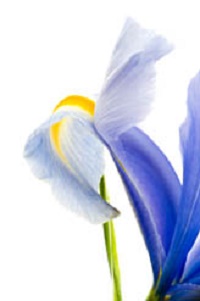The Herb Garden
The Joy of Growing and Using Herbs
Iris
by Rachel McLeod
In Greek mythology, Iris was the messenger of the gods. She was always depicted with rainbow wings. And it is from this association that the iris plant got its name. Certainly irises are the rainbows of the early summer gardens as they range from the deep purples, browns and bronzes to the delicate sky blue and pink with gold in between; just to look at them makes one feel inspired, healthy and full of joy.
They are one of the givers of health by their beauty. Just as the scents of flowers promote healing in aromatherapy, surely the enjoyment of looking at beautiful flowers must also have a therapeutic effect on our bodies. However, we can hardly have such a rainbow of irises in the herb garden: They take up a lot of space and most of them do not have the chemical constituents to qualify as herbs.
There are a few species of iris, though, which have herbal qualities and are most welcome in the herb garden. With their sword-like foliage, these plants will give an architectural accent throughout the year and when in flower will add a strong yellow, blue or delicate white and blue shimmer to the garden.
These are plants that have been grown and used for a long time. They are part of the history of North American Indians. There are records since the Middle Ages of their use by European herbalists and more records show the use of irises in Egypt as far back as 1540 BC.
The most important herbal use for irises to day is the use of the rhizomes from certain species to make orris root for use in perfumery and pot-pourri. Orris root has been one of the most important ingredients in any scent industry from as far back as the 15th century. The scent is rather like sweet violets but its real value is in its ability to fix other scents. It is now especially used in pot-pourri where the oil of the scent required is dropped onto the orris root and then mixed with the other dried ingredients.
Orris root comes from three closely related irises – Iris germanica, Iris florentina and Iris pallida. Much of the orris root used today is grown in Italy. It takes two to three years for the iris to grow to maturity before the rhizome is harvested. The rhizome should be dug, then peeled and grated or chopped while still fresh and soft. Then it has to be left to dry for at least two years before the scent is at maximum strength.
Iris florentina might be the best choice of the three for the herb garden. It is scented and coloured a whitish mauve, giving what author and gardener Patrick Lima calls a “blurred opalescent” effect, which will be enhanced by placing it in front of a darker background.
Quite different herbal irises are the blue and yellow flags – Iris versicolor and Iris pseudacorus. The former is native to North America but the yellow iris is an alien from Europe which has made itself at home here. Both prefer damp soil, unlike the orris root species, which prefer fairly dry, well drained positions. I find the yellow flag grows magnificently in a meadow grown over a tile bed. Iris versicolor is smaller but very pretty. It needs an open, boggy site where it will make large clumps and the blue of the flowers is a reflection of the sky above.
The roots of these irises have been used medicinally in the past for various purposes but they have been shown to be a dangerous purgative and should never be used medicinally at home. The blue flag, however, has been used extensively by North American Indians for poultices for any type of swelling, burns and sores. It also has been recorded that the aroma of the root will keep snakes away. Author and herbalist Charlotte Erichsen-Brown notes that Indians in Arizona use it in snake dances and will even chew it so that they can safely take rattlesnakes into their mouths!
The yellow flag has been used in the past medicinally for coughs and bruises but it too proved too dangerous as a purgative and is not used now.
Finally, an interesting iris, which also used to be used medicinally, goes by the curious name of roast beef plant because of its odour. Its botanical name is Iris foetidissima and it is also known as stinking gladwin or gladdon. In the past it, too, was found to be dangerous and is no longer used. It is an evergreen perennial, its flowers are not very conspicuous but its main glory is its seed pods, which are long lasting and open to display brilliant red seeds. This is a plant I would like to add to my garden, as it prefers to grow in the shade. It’s one of the plants I’ll be looking for this year.
Rachel McLeod founded Kiln Farm Herb Garden in Puslinch, Ontario in 1974.
|

